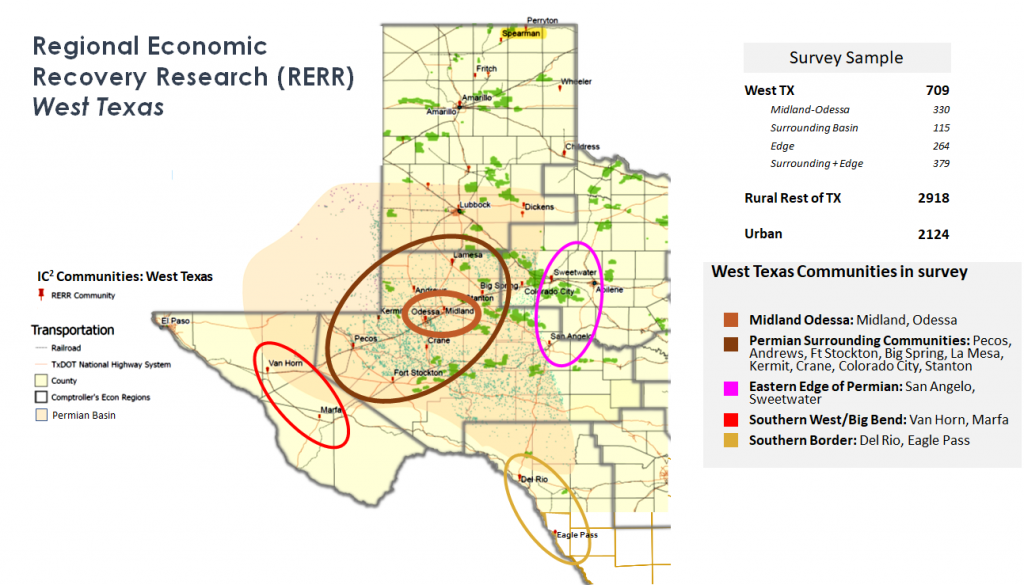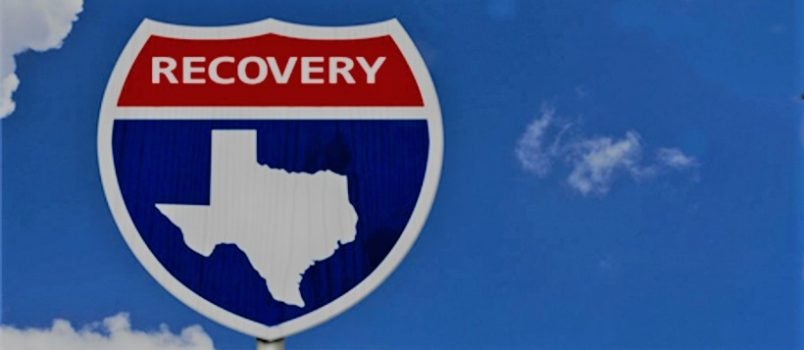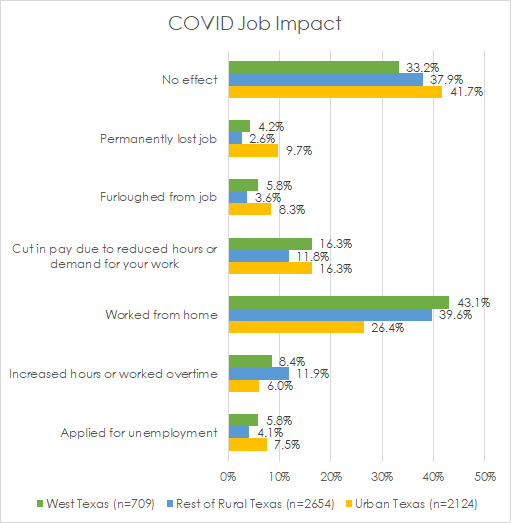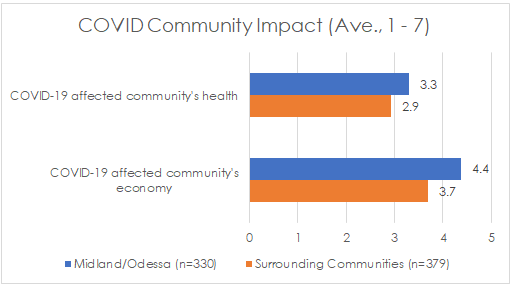
March 4, 2021
As part of the IC2 Institute’s Regional Economic Recovery Initiative, launched in March 2020 to better understand Texas communities and provide evidence-based recommendations for next steps for community planning, the Bureau of Business Research surveyed Texans from across the state about their economic development priorities. Among the issues covered in the survey, which was fielded in the summer of 2020, was a battery of questions about how the COVID pandemic was affecting their health, their families, their jobs, and their communities.
The survey included 7500 participants from rural communities and small cities that range in population size from Crane (pop. 3800) to Amarillo (pop. 200,000). We compared those survey responses to the responses we received from the giving the same survey to 2000 residents in Texas’ five largest metropolitan areas (Houston, Dallas, San Antonio, El Paso, and Austin) to explore potential differences in attitudes toward economic development around the state. More on research methodology here.

West Texas Focus
The survey and analysis were funded in part by the Cynthia and George Mitchell Foundation and the Carl B. and Florence E. King Foundation to explore particular economic development trends and strategies for West Texas and the Permian Basin. In this analysis, we highlight the West Texas region, in particular, to explore regional variation. The findings presented below illustrate different perceptions of impact between urban and rural Texans. To further drill into West Texas, some of the charts compare Midland/Odessa participants with smaller Permian Basin communities like Pecos, Andrews, and Crane, as well as Permian-adjacent towns like Del Rio and Sweetwater. (The number of responses to the question appears at the bottom of the chart; participants were not required to answer all questions.)
Chart 1 – COVID Health Impact
Chart 1 shows, at least in the summer months and before the third big wave of cases hit during the winter holidays, that rural Texans’ health was less affected by the virus, although West Texans reported slightly higher levels of secondary mental health stress.
Chart 2 – COVID Job Impact
Chart 2 responses show a considerable variation between urban and rural Texans’ perceptions of the impact of COVID on their job situations. Surprisingly, more West Texas respondents said they were able to work from home compared to urban respondents, and more urban residents reported permanently losing their jobs (9.7%) than did rural residents (4.2%), indicating that employment stress might have been greater in urban areas than in rural parts of the state. A higher percentage of rural respondents reported having worked more hours at their jobs during the pandemic, and fewer rural respondents applied for unemployment.
Chart 3 – COVID Job Impacts [Midland/Odessa & Surrounding Communities]
Chart 3 focuses only on West Texas and compares Midland/Odessa with surrounding communities. Fewer respondents from smaller communities in West Texas reported being able to work from home during COVID, but more of them said they had had their hours increased or had worked overtime during the pandemic, and fewer respondents from the smaller surrounding communities reported having to take a cut in pay than respondents in Midland/Odessa. Context matters, of course: Small towns in the Permian Basin are dependent on oil and gas drilling, and many jobs in that sector cannot be done from home. But that pattern may be repeating itself in other rural parts of Texas, where broadband access is spotty and jobs are oriented toward farming and ranching and can’t be done in offices from desks.
Chart 4 – COVID Impact on the Community
Finally, the survey asked people about their perceptions of how COVID had affected their community. Participants were asked to rate the impact on a scale of 1 to 7 (with 1 being low impact, 7 being a large impact). Chart 4 shows that urban participants generally felt that COVID had affected their community’s health and economy about the same (an average of 3.4 on the scale of 1-7). West Texans, by comparison, thought that the economic impact of the pandemic was more profound than its health impacts on their community, perhaps because of the downturn in the oil patch. Rural survey participants believed that the health impacts on their community was less severe (2.7 average) than urban participants (3.4 average).
Texas COVID Cases Declining
Today, Texas is dropping back to a COVID caseload approximating the load that state was experiencing when we fielded the survey. While COVID conditions are improving, especially with the vaccine rollout underway, the state is still battling high rates of new cases, hospitalizations, and deaths from the pandemic. The survey finding presented here, from earlier in the pandemic, may illuminate the enduring impacts of the pandemic across the state, especially on residents of smaller communities in Texas.
 Return to Regional Economic Recovery Research- Main
Return to Regional Economic Recovery Research- Main
We encourage your feedback and would like to hear from you. Email BBR Director, Dr. Bruce Kellison, with questions about the survey, the findings, or the analysis presented here.






